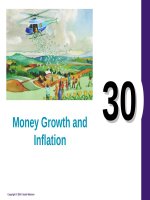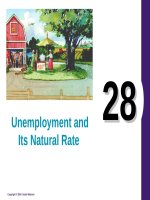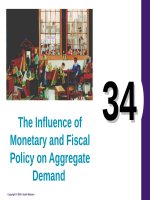Lecture Principles of economics - Chapter 30: Money growth and inflation
Bạn đang xem bản rút gọn của tài liệu. Xem và tải ngay bản đầy đủ của tài liệu tại đây (565.64 KB, 45 trang )
Money Growth and
Inflation
Copyright © 2004 South-Western
30
The Meaning of Money
• Money is the set of assets in an economy that
people regularly use to buy goods and services
from other people.
Copyright © 2004 South-Western
THE CLASSICAL THEORY OF
INFLATION
• Inflation is an increase in the overall level of
prices.
• Hyperinflation is an extraordinarily high rate of
inflation.
Copyright © 2004 South-Western
THE CLASSICAL THEORY OF
INFLATION
• Inflation: Historical Aspects
• Over the past 60 years, prices have risen on average
about 5 percent per year.
• Deflation, meaning decreasing average prices,
occurred in the U.S. in the nineteenth century.
• Hyperinflation refers to high rates of inflation such
as Germany experienced in the 1920s.
Copyright © 2004 South-Western
THE CLASSICAL THEORY OF
INFLATION
• Inflation: Historical Aspects
• In the 1970s prices rose by 7 percent per year.
• During the 1990s, prices rose at an average rate of 2
percent per year.
Copyright © 2004 South-Western
THE CLASSICAL THEORY OF
INFLATION
• The quantity theory of money is used to explain
the longrun determinants of the price level and
the inflation rate.
• Inflation is an economywide phenomenon that
concerns the value of the economy’s medium of
exchange.
• When the overall price level rises, the value of
money falls.
Copyright © 2004 South-Western
Money Supply, Money Demand, and
Monetary Equilibrium
• The money supply is a policy variable that is
controlled by the Fed.
• Through instruments such as openmarket
operations, the Fed directly controls the quantity of
money supplied.
Copyright © 2004 South-Western
Money Supply, Money Demand, and
Monetary Equilibrium
• Money demand has several determinants,
including interest rates and the average level of
prices in the economy.
Copyright © 2004 South-Western
Money Supply, Money Demand, and
Monetary Equilibrium
• People hold money because it is the medium of
exchange.
• The amount of money people choose to hold
depends on the prices of goods and services.
Copyright © 2004 South-Western
Money Supply, Money Demand, and
Monetary Equilibrium
• In the long run, the overall level of prices
adjusts to the level at which the demand for
money equals the supply.
Copyright © 2004 South-Western
Figure 1 Money Supply, Money Demand, and the
Equilibrium Price Level
Value of
Money, 1/P
(High)
Price
Level, P
Money supply
1
1
1.33
3
/4
/
12
Equilibrium
value of
money
(Low)
(Low)
A
2
Equilibrium
price level
4
14
/
Money
demand
0
Quantity fixed
by the Fed
Quantity of
Money
(High)
Copyright © 2004 South-Western
Figure 2 The Effects of Monetary Injection
Value of
Money, 1/P
(High)
MS1
MS2
1
1
1. An increase
in the money
supply . . .
3
2. . . . decreases
the value of
money . . .
Price
Level, P
/4
12
/
1.33
A
2
B
/
14
(Low)
3. . . . and
increases
the price
level.
4
Money
demand
(High)
(Low)
0
M1
M2
Quantity of
Money
Copyright © 2004 South-Western
THE CLASSICAL THEORY OF
INFLATION
• The Quantity Theory of Money
• How the price level is determined and why it might
change over time is called the quantity theory of
money.
• The quantity of money available in the economy
determines the value of money.
• The primary cause of inflation is the growth in the
quantity of money.
Copyright © 2004 South-Western
The Classical Dichotomy and Monetary
Neutrality
• Nominal variables are variables measured in
monetary units.
• Real variables are variables measured in
physical units.
Copyright © 2004 South-Western
The Classical Dichotomy and Monetary
Neutrality
• According to Hume and others, real economic
variables do not change with changes in the
money supply.
• According to the classical dichotomy, different
forces influence real and nominal variables.
• Changes in the money supply affect nominal
variables but not real variables.
Copyright © 2004 South-Western
The Classical Dichotomy and Monetary
Neutrality
• The irrelevance of monetary changes for real
variables is called monetary neutrality.
Copyright © 2004 South-Western
Velocity and the Quantity Equation
• The velocity of money refers to the speed at
which the typical dollar bill travels around the
economy from wallet to wallet.
Copyright © 2004 South-Western
Velocity and the Quantity Equation
V = (P Y)/M
• Where: V = velocity
P = the price level
Y = the quantity of output
M = the quantity of money
Copyright © 2004 South-Western
Velocity and the Quantity Equation
• Rewriting the equation gives the quantity
equation:
M V = P Y
Copyright © 2004 South-Western
Velocity and the Quantity Equation
• The quantity equation relates the quantity of
money (M) to the nominal value of output
(P Y).
Copyright © 2004 South-Western
Velocity and the Quantity Equation
• The quantity equation shows that an increase in
the quantity of money in an economy must be
reflected in one of three other variables:
• the price level must rise,
• the quantity of output must rise, or
• the velocity of money must fall.
Copyright © 2004 South-Western
Figure 3 Nominal GDP, the Quantity of Money, and
the Velocity of Money
Indexes
(1960 = 100)
2,000
Nominal GDP
1,500
M2
1,000
500
Velocity
0
1960
1965
1970
1975
1980
1985
1990
1995
2000
Copyright © 2004 South-Western
Velocity and the Quantity Equation
• The Equilibrium Price Level, Inflation Rate,
and the Quantity Theory of Money
• The velocity of money is relatively stable over time.
• When the Fed changes the quantity of money, it
causes proportionate changes in the nominal value
of output (P Y).
• Because money is neutral, money does not affect
output.
Copyright © 2004 South-Western
CASE STUDY: Money and Prices during
Four Hyperinflations
• Hyperinflation is inflation that exceeds 50
percent per month.
• Hyperinflation occurs in some countries
because the government prints too much money
to pay for its spending.
Copyright © 2004 South-Western
Figure 4 Money and Prices During Four
Hyperinflations
(a) Austria
(b) Hungary
Index
(Jan. 1921 = 100)
Index
(July 1921 = 100)
100,000
100,000
Price level
Price level
10,000
10,000
Money supply
1,000
100
Money supply
1,000
1921
1922
1923
1924
1925
100
1921
1922
1923
1924
Copyright © 2004 South-Western
1925









